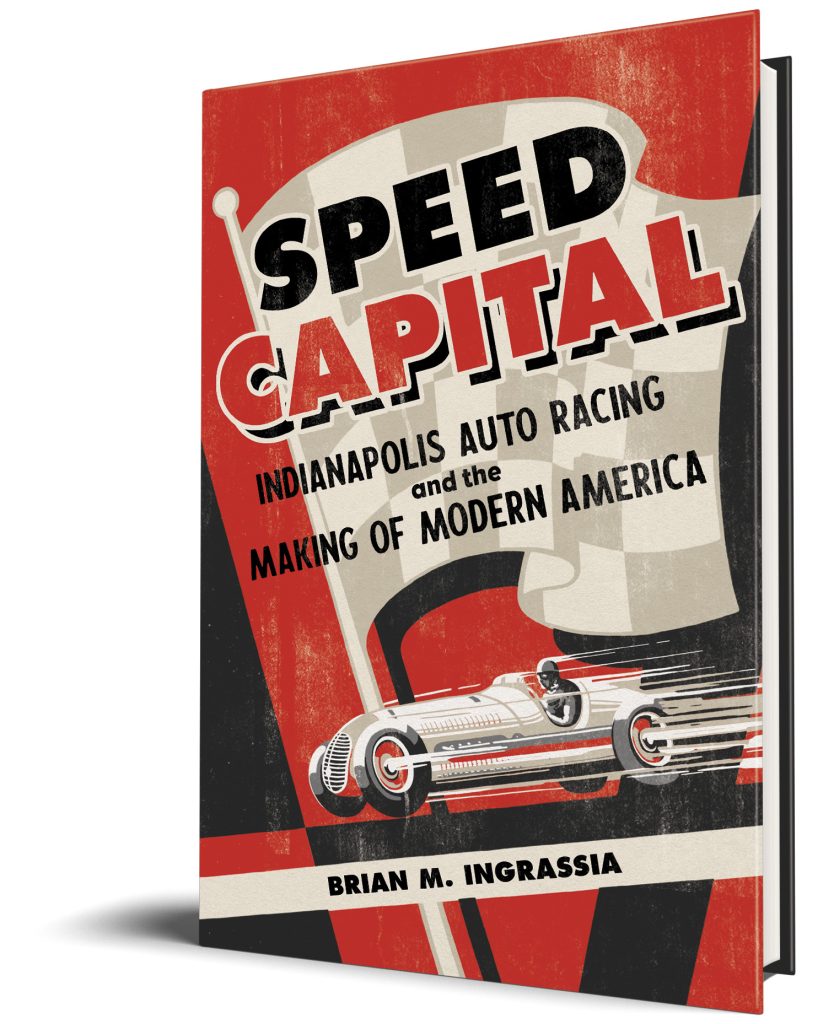Brian M. Ingrassia, author of Speed Capital: Indianapolis Auto Racing and the Making of Modern America, answers questions on his new book.
Q: Why did you decide to write this book?
While I was writing my dissertation on college football reform in the Progressive Era, I took several research trips, including one to Boston in 2006. I had never lived in a big city before, and I started to get interested in urban history, especially regarding urban planning and transportation infrastructure. Upon returning home after my time in Boston, I started making occasional trips to Indianapolis, which is relatively close to Champaign, Illinois, where I was living at the time. On one of those trips, about July 2007, I drove by the Indianapolis Motor Speedway (not my first time), and realized it was actually located in a place called “Speedway.” I figured I should learn more about this place oriented around speed. When I figured out no one had yet written anything scholarly on the town—and also that nothing academic had been written about the track itself—I decided to do a little research. That’s how I learned about Carl Graham Fisher and his role in building the speedway, as well as Speedway City and Miami Beach, plus the Lincoln and Dixie Highways. I got really excited—I realized that there must be some connection between all of these places and Fisher’s attempts to rebuild space and make it quicker for people to get from one place to another. It turned out to be a fascinating story.
Q: What is the most interesting discovery you made while researching and writing your book?
One of the most surprising things I learned while researching Speed Capital is that the famous Black boxer Jack Johnson tried to race at Indianapolis in 1910, but he was barred because of his race/skin color. Carl Fisher might have been ok with the publicity that Johnson would have brought to the track, but white drivers (including Louis Chevrolet) were not. They fought to protect their labor from the supposed threat of a nonwhite competitor—it was a total “wages of whiteness” kind of moment. Although there are several really great Jack Johnson biographies out there, I couldn’t find this story in any of them. We know that Johnson raced Barney Oldfield on the East Coast—and Oldfield got banned (temporarily) as a result of those events—but no one has really talked about Johnson’s attempts to compete at Indianapolis, even though it was reported in newspapers like the New York Times. Another interesting discovery I made is that there was a fairly serious discussion in the 1920s about turning part of the speedway’s infield into an airport. It never happened, but Indianapolis could have been like Atlanta or Minneapolis, with a major airport built on a former race track.
Q: What myths do you hope your book will dispel or what do you hope your book will help readers unlearn?
There are so many myths surrounding the Indianapolis Motor Speedway, but one of the biggest is that it was explicitly built as a proving ground for automotive technology. That story has even been written into the Congressional Record. Although automotive technology certainly was developed and tested at the speedway, my research shows that it was built more as a place for entertaining spectacle, as well as a place where all kinds of “space-annihilating” technologies and events could be promoted. It’s no coincidence that the first event at the speedway in June 1909 was a balloon contest. The balloons weren’t just a publicity stunt—they were another way (like race cars) of breaking down spatial barriers between different places. The track was not simply an automotive proving ground.
Q: Which part of the publishing process did you find the most interesting?
This is my second book, and I always really love the process of taking an early draft and polishing it so that the narrative reads like an actual book that people would want to buy and read cover to cover. Although locating the forty-plus images was stressful, I was really pleased with the photos we ended up with, along with the two maps that a friend and former colleague in Tennessee made. I think the illustrations add a lot to the finished product.
Q: What is your advice to scholars/authors who want to take on a similar project?
Remember that it’s a marathon, not a sprint. To do something like this—especially if you’re teaching a full course load—takes a lot of time. I chuckle when I read the preface to a trade-press book and the author boasts about the two or three years it took to research and write it. That’s really quick! And remember that some of the most fun parts of writing a history book are when you get to travel to archives and dig into original records. I always learn a lot by going to the places I am writing about. In the case of Speed Capital, the story is more interesting because I spent time in Miami, thinking about differences between Speedway City and Miami Beach, plus Carl Fisher’s role in creating both places.
Q: What do you like to read/watch/or listen to for fun?
I read a lot of American history, obviously, but I also enjoy nonfiction books about science and popular music, as well as some classic science fiction and fantasy series. I am an avid record collector, with about 700 or more vinyl LPs I started collecting in the mid-1990s, when people were basically throwing records away and replacing them with CDs. I like classic rock, outlaw country, early heavy metal, and 1970s folk-pop. I have played guitar since I was seven years old, but right now my playing is on hiatus due to a broken hand. I am looking forward to getting back to making music soon!

Brian M. Ingrassia is an associate professor of history at West Texas A&M University and the author of The Rise of Gridiron University: Higher Education’s Uneasy Alliance with Big-Time Football.

